Marine Fish for Beginners
1- Clownfish :
-Ocellaris Clownfish
Amphiprion ocellaris
Minimum Tank Size: 20 gallons
Care Level: Easy
Temperament: Peaceful
Reef Compatible: Yes
Water Conditions: 72-78° F, dKH 8-12, pH 8.1-8.4, sg 1.020-1.025
Max. Size: 3"
Color Form: Black, Orange, White
Diet: Omnivore
Compatibility: View Chart
Origin: Captive-Bred - Africa, Captive-Bred - USA
Family: Pomacentridae
The Ocellaris Clownfish may be one of the aquarium industry's most popular marine fish. Its beautiful orange body dressed with white bands outlined in black instantly distinguishes the Ocellaris Clownfish. This member of the Pomacentridae family is an excellent addition to almost any saltwater aquarium system. What makes this specific variety even more appealing to aquarists is the fact that each Ocellaris Clownfish is captive-bred to help protect the fragile reef environments of the world.
The Captive-Bred Ocellaris Clownfish has other unique advantages over wild-harvested species. For one, the Captive-Bred Ocellaris Clownfish is very hardy and more accustomed to conditions found in home aquariums. Therefore, it makes a great choice for novices and seasoned aquarists alike. The Captive-Bred Ocellaris Clownfish can also be kept with a variety of other captive-bred clownfish, if introduced into the aquarium at the same time.
The Captive-Bred Ocellaris Clownfish is also easy to breed in the home aquarium. The females will be the largest of the pair and the two fish will usually stay close to each other in the aquarium. The Captive-Bred Ocellaris Clownfish is an egg layer and will deposit the eggs on a flat surface and defend the eggs from other tankmates. The eggs will normally hatch in 6-11 days depending on the water temperature. The fry must be reared in a separate aquarium on a diet of rotifers followed by baby brine shrimp.
The Captive-Bred Ocellaris Clownfish is also known as the False Percula Clownfish, False Clown Anemonefish, and Anemone Demoiselle. This fish is sometimes sold as the Percula Clown, even though it is not. The color pattern is very similar, but it is not as bright orange. The Captive-Bred Ocellaris is usually significantly lighter in coloration and is often missing one or more stripes. It may also have non-symmetrical stripes on the sides of its body, making the Captive-Bred Ocellaris Clownfish unusual and appealing to most hobbyists. The coloration of these fish will darken to a nice solid orange with age.
This Clownfish is an aggressive eater. It will accept most meaty foods and frozen herbivore preparations.
Approximate Purchase Size: Small: 3/4" to 1-1/4" Medium: 1-1/4" to 1-3/4"; Large: 1-3/4" to 3"

-Black & White Ocellaris Clownfish,
Amphiprion ocellaris var.
( Similar to above )
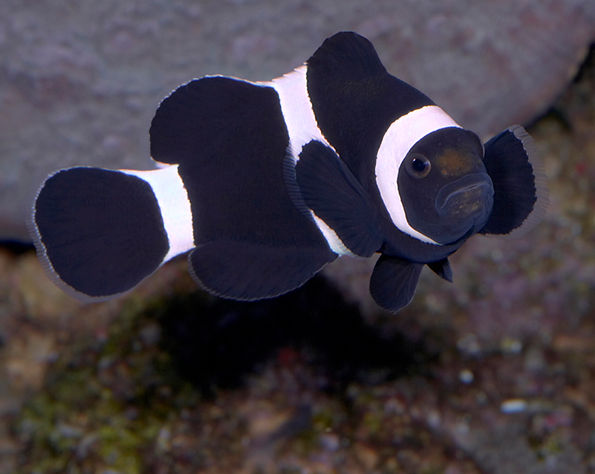
-Black Ice Ocellaris Clownfish
Amphiprion ocellaris
( Similar to above )
-Snowflake Ocellaris Clownfish
Amphiprion ocellaris
( Similar to above )
-Midnight Ocellaris Clownfish
Amphiprion ocellaris var.
( Similar to above )
-Semi Picasso Percula Clownfish, Amphiprion percula
( Similar to above )
-Pearl Eye Clarkii Clownfish Amphiprion clarkii
( Similar to above )
-Galaxy Clarkii Clownfish
Amphiprion clarkii
( Similar to above )
-Red Saddle Clownfish
Amphiprion ephippium
( Similar to above )
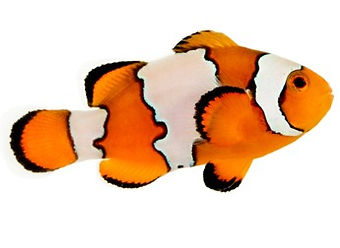

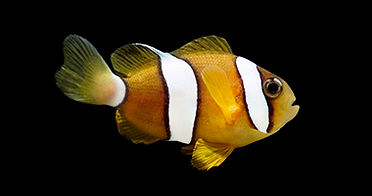
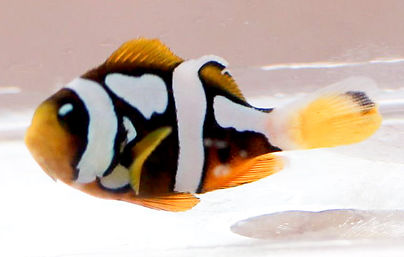



2-Kaudern's Cardinalfish
Pterapogon kauderni :
Minimum Tank Size: 30 gallons
Care Level: Easy
Temperament: Semi-aggressive
Reef Compatible: Yes
Water Conditions: 72-78° F, dKH 8-12, pH 8.1-8.4, sg 1.020-1.025
Max. Size: 3"
Color Form: Black, White
Diet: Carnivore
Compatibility: View Chart
Origin: Captive-Bred - Asia
Family: Apogonidae
The Kaudern's Cardinal, also known as the Banggai Cardinalfish or Longfin Cardinalfish, is silver highlighted by black stripes and white spots on the body and long, elegant fins. These fish are bred in and reared in Indonesia and Asia and are hardier than their wild harvested counterparts.
A 30 gallon or larger aquarium with a cave and peaceful tank mates is ideal for this slow and methodical swimmer. Due to its aggressive behavior towards conspecifics, it should not be kept in large groups, though they do like to have a few other Cardinalfish around.
The Kaudern's Cardinal is relatively easy to breed in the aquarium setting. Once spawning has occurred, the male carries the eggs in his mouth to protect them.
The Kaudern's Cardinal should be fed a well balanced diet of meaty foods such as feeder shrimp, marine flesh,bloodworms, and depending on its size, live feeder fish.
Approximate Purchase Size: Small: 1/2" to 3/4" Medium: 7/8" to 1"
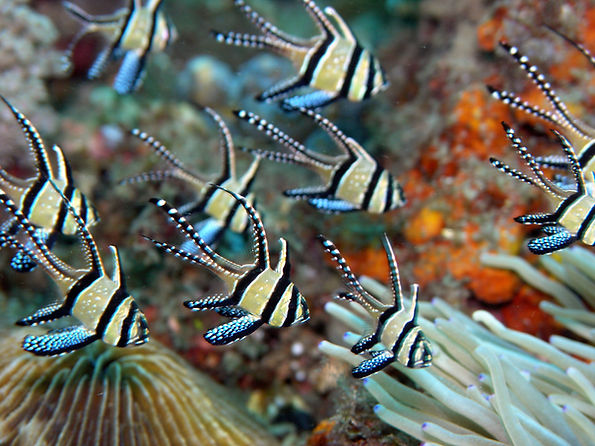
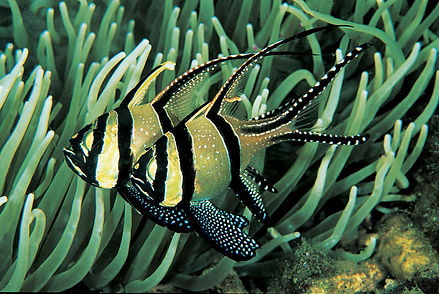
3-Pajama Cardinalfish
Sphaeramia nematoptera
Minimum Tank Size: 30 gallons
Care Level: Easy
Temperament: Peaceful
Reef Compatible: Yes
Water Conditions: 72-78° F, dKH 8-12, pH 8.1-8.4, sg 1.020-1.025
Max. Size: 3½"
Color Form: Green, White
Diet: Carnivore
Compatibility: View Chart
Origin: Fiji, Indonesia, Sri Lanka
Family: Apogonidae
The Pajama Cardinalfish is a rainbow of playful colors. It has a greenish-yellow face, bright orange eyes, and a silver-based body dressed with a bold black scalar margin and a posterior dotted with orange polka-dots. Though its bold coloration may stand out, Sphaeramia nematopterahas a peaceful nature that lets it blend perfectly into any community saltwater aquarium.
For the best care, the Pajama Cardinalfish should be kept in small schools in suitably sized aquariums of at least 30 gallons. Because the Pajama Cardinalfish is a slow and methodical swimmer, it should be housed with peaceful tankmates and offered a plethora of hiding places amongst rockwork or plants. Most Pajama Cardinalfish will tend to hide in sea grass or other plants. Some may also camouflage themselves against long spined sea urchins.
Like many other schooling fish, the Pajama Cardinalfish will form a strict hierarchy when kept in small groups within the aquarium. However, unlike some social fish, this member of the Apogonidae family does not use aggression to exert dominance over other cardinalfish.
The Pajama Cardinalfish requires a well balanced diet of meaty foods such as feeder shrimp, flake foods, pellet foods, marine flesh, bloodworms, and depending on its size, live feeder fish.
Approximate Purchase Size: Small: 3/4" to 1-1/4" Medium: 1-1/4" to 2-1/4"
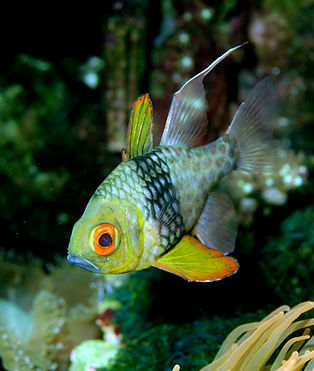
4- Blue/Green Reef Chromis
Chromis viridis
Minimum Tank Size: 30 gallons
Care Level: Easy
Temperament: Peaceful
Reef Compatible: Yes
Water Conditions: 72-78° F, dKH 8-12, pH 8.1-8.4, sg 1.020-1.025
Max. Size: 3½"
Color Form: Blue
Diet: Omnivore
Compatibility: View Chart
Origin: Africa, Indonesia, Pen Raised
Family: Pomacentridae
The Blue Green Reef Chromis is easy to care for, beautiful, and peaceful. In fact, Chromis viridis is one of the preferred marine reef fish amongst aquarists, regardless of their experience level. This member of the Pomacentridae family is most recognizable by its gorgeous light blue dorsal side that slowly fades into a majestic pale green belly. The Blue Green Reef Chromis is desirable not only for its beauty, but also for its peaceful demeanor (despite its designation as a true damselfish) and ability to be kept with almost all other community fish, invertebrates, and corals.
Native to reefs ranging from mid-depth to shallow lagoons of the Indo-Pacific and South Pacific, wild specimens prefer to school in large shoals amongst branching corals like Acropora. In the home aquarium, the Blue Green Reef Chromis does best in similar environments and will actively swim at all levels of the aquarium water column. In fact, small schools of the Blue Green Reef Chromis add a dazzling and dramatic shimmer of beauty to almost any well-established reef system.
Overall, the Blue Green Reef Chromis is very hardy and can live between 8 to 15 years in aquariums with excellent water quality. For best care, feed several times throughout the day with a varied diet of meaty foods, herbivore flakes, and frozen preparations. Vitamin-enriched foods may also help to preserve body colorations.
Some aquarists have successfully bred the Blue Green Reef Chromis in the home aquarium. Interestingly, the body color of mature males, ready to nest, changes to a muted yellow color. However, breeding success requires perfect water parameters in only the largest of non-predatory aquarium systems.
Approximate Purchase Size: Small 1/2" to 1" Medium: 1" to 2"; Large 2" to 3"

6- Royal Gramma Basslet
Gramma loreto
Minimum Tank Size: 30 gallons
Care Level: Easy
Temperament: Peaceful
Reef Compatible: Yes
Water Conditions: 72-78° F, dKH 8-12, pH 8.1-8.4, sg 1.020-1.025
Max. Size: 3"
Color Form: Purple, Yellow
Diet: Carnivore
Compatibility: View Chart
Origin: Caribbean, Tropical Western Pacific
Family: Grammidae
The Royal Gramma Basslet brings an explosion of color to any saltwater aquarium. It has a bright purple to violet colored anterior contrasted by a vibrant yellow posterior. Coveted for both its unique color pattern and relatively small adult size, Gramma loreto is well suited for small nano reef systems.
Native to the deep-water reefs of the Caribbean, this member of the Grammidae family prefers extensive rockwork caves in which to hide and somewhat subdued lighting. Since it demonstrates territorial aggression towards its own kind, the Royal Gramma Basslet should be housed singly. However, most Royal Gramma Basslets are peaceful towards tankmates of similar size and temperament.
For the best care, keep the Royal Gramma Basslet in reef systems of at least 30 gallons. Since it is a carnivore, feed a varied diet of meaty fare, including marine fish, crustacean flesh, mysis shrimp, and quality frozen preparations.
Approximate Purchase Size: Small: 3/4" to 1-1/4"; Medium: 1-1/4" to 1-3/4"; Large: 1-3/4" to 2-1/2"

7- Bicolor Blenny
Ecsenius bicolor
Minimum Tank Size: 30 gallons
Care Level: Easy
Temperament: Peaceful
Reef Compatible: Yes
Water Conditions: 72-78° F, dKH 8-12, pH 8.1-8.4, sg 1.021-1.023
Max. Size: 4"
Color Form: Blue, Orange
Diet: Herbivore
Compatibility: View Chart
Origin: Fiji, Indonesia, Sri Lanka
Family: Blenniidae
The Bicolor Blenny is also known as the Two-colored Blenny. The Bicolor is so-named because the anterior half is blue to dull brown, and the posterior half is dull orange. Males are generally larger than females and experience a succession of color changes, including blue, when breeding. These Blennies exhibit great personality in the aquarium.
Generally found amid crevices and rocks on the bottom of its environment, the Bicolor Blenny needs a tank of at least 30 gallons with scattered rocks for perching and hiding.
These fishes are normally peaceful tank members, but have been known to pick at other blennies, smaller gobies and dartfish. They normally make a good addition to reef aquariums, but use caution in smaller set ups, or with smaller fleshy corals, as they have been know to pick at the mantles of clams, and at fleshy large polyp stony corals when underfed. In larger reef aquariums they rarely do damage to these corals or clams.
The diet of the Bicolor Blenny should include vegetable matter, including frozen and dried foods containing marine and blue-green algae. It will also feed on (and help control) algae growing in the aquarium.
Approximate Purchase Size: Small 1-1/4" to 2"; Medium 2" to 3"; Large 3" to 4"

8- Sailfin/Algae Blenny
Salarias fasciatus
Minimum Tank Size: 30 gallons
Care Level: Easy, Moderate
Temperament: Peaceful
Reef Compatible: Yes
Water Conditions: 72-78° F, dKH 8-12, pH 8.1-8.4, sg 1.020-1.025
Max. Size: 5"
Color Form: Assorted, Green, Tan
Diet: Herbivore
Compatibility: View Chart
Origin: Fiji, Indonesia, Solomon Islands
Family: Blenniidae
The Sailfin/Algae Blenny is notable for its unique looks and winning personality. With a mottled tan color, oversized eyes, and typical body shape of the Blenniidae family,Salarias fasciatus adds visual appeal to any marine aquarium. But despite its tendency to grow to an impressive 5" in size in the home aquarium, the Sailfin/Algae Blenny remains peaceful, active and, therefore, fun to observe.
Also referred to as the Jewelled Rockskipper, Lawnmower, or Rock Blenny, the Sailfin/Algae Blenny is native to the reefs across the Indo-Pacific. Like other Blennies, the Sailfin/Algae Blenny will perch on live rock, hide in caves, hop across the substrate, and graze on microalgae. Therefore, it requires a larger system with a variety of live rock and rockwork.
The Sailfin/Algae Blenny is peaceful towards other fish unless the tank mate is similar in shape or appearance to the blenny. It is best to house the Sailfin/Algae Blenny singly unless kept in a larger aquarium and the two are a mated pair. It is known to nip at small-polyped stony coral and clam mantles.
The Sailfin/Algae Blenny does best in well-established aquariums with large amounts of natural algae to feed on. The diet can be supplemented with vegetable matter, spirulina, and herbivore preparations.

9- Midas Blenny
Ecsenius midas
Minimum Tank Size: 30 gallons
Care Level: Easy
Temperament: Peaceful
Reef Compatible: Yes
Water Conditions: 72-78° F, dKH 8-12, pH 8.1-8.4, sg 1.020-1.025
Max. Size: 6"
Color Form: Black, Blue, Brown, Yellow
Diet: Omnivore
Compatibility: View Chart
Origin: Africa, Fiji, Indonesia, Maldives
Family: Blenniidae
The Midas Blenny is an excellent candidate for a reef tank. It is a beautiful, deep golden-yellow with a shadow of blue under the chin and bright, blue-rimmed eyes. When swimming, the motion they use is very eel-like.
This blenny will appreciate a minimum tank of 30 gallons or larger with numerous rocks on which to perch. Sometimes, the Midas Blenny will vex small planktivores and has been known to nip at firefish and gobies. Larger tanks are advantageous as many of the Midas Blenny's aggressive behavior traits seem to relate to a confining tank situation.
Unlike most blennies, the Midas Blenny requires a meaty diet including finely chopped crustacean flesh, mysis and vitamin-enriched brine shrimp, along with frozen herbivorous preparations, micro and blue-green algae.
Approximate Purchase Size: Small: 1" to 2"; Medium: 2" to 3"; Large: 3" to 4"; X Large 4" to 6"

10- Tail Spot Blenny
Ecsenius stigmatura
Minimum Tank Size: 10 gallons
Care Level: Easy
Temperament: Peaceful
Reef Compatible: Yes
Water Conditions: 72-78° F, dKH 8-12, pH 8.1-8.4, sg 1.020-1.025
Max. Size: 2½"
Color Form: Black, Blue, Orange, Yellow
Diet: Herbivore
Compatibility: View Chart
Origin: Cebu
Family: Blenniidae
The Tail Spot Blenny's defining feature is the dark spot at the base of its tail. A black and yellow band runs below each eye, aiding them in blending into their surroundings. They are a smaller blenny with very large eyes, and small mouth giving these fish a very comical look.
Generally found amid crevices and rocks on the bottom of its environment, the Tail Spot Blenny needs a tank of at least 10 gallons with plenty of live rock for grazing, perching and hiding. They should not be housed with aggressive species that may intimidate these fish into hiding.
The diet of the Tail Spot Blenny should include vegetable matter, including frozen and dried foods containing marine and blue-green algae. It will also feed on (and help control) algae growing in the aquarium.
Approximate Purchase Size: 3/4" to 1-1/2"

11-Linear Blenny
Ecsenius lineatus
Minimum Tank Size: 30 gallons
Care Level: Easy
Temperament: Peaceful
Reef Compatible: Yes
Water Conditions: 72-78° F, dKH 8-12, pH 8.1-8.4, sg 1.020-1.025
Max. Size: 3½"
Color Form: Black, Tan, White
Diet: Herbivore
Compatibility: View Chart
Origin: South Asia
Family: Blenniidae
The Linear Blenny is also known as the Lined Blenny. The lower half is white and the upper half is brown to black in coloration. They are a smaller blenny. Their very large eyes and small mouth give these fish a very comical look. Linear Blennies are a great addition to any reef or peaceful fish-only aquarium, large or small.
Generally found amid crevices and rocks on the bottom of its environment, the Linear Blenny needs a tank of at least 30 gallons with plenty of live rock for grazing, perching, and hiding. They should not be housed with aggressive species that may intimidate these fish into hiding.
The Linear Blenny is a perfect candidate for the reef aquarium and is considered reef safe but may nip at the polyps or bases of Acropora sp. and other SPS corals. If the SPS dominated aquarium is not heavily stocked with mature colonies these fish may damage Acropora sp. and Montipora sp. in these displays.
The diet of the Linear Blenny should include vegetable matter, including frozen and dried foods containing marine and blue-green algae. It will also feed on (and help control) algae growing in the aquarium.
Approximate Purchase Size: Small: 3/4" to 1"; Medium: 1" to 2" Large: 2" to 3"

12- Snowflake Eel
Echidna nebulosa
Minimum Tank Size: 50 gallons
Care Level: Easy
Temperament: Semi-aggressive
Reef Compatible: With Caution
Water Conditions: 72-78° F, dKH 8-12, pH 8.1-8.4, sg 1.020-1.025
Max. Size: 2'
Color Form: Black, Tan, White
Diet: Carnivore
Compatibility: View Chart
Origin: Indonesia, Vanuatu
Family: Muraenidae
The Snowflake Eel, also known as the Snowflake Moray Eel, Clouded Moray, or Starry Moray, is one of the most beautiful morays, and inhabits caves and crevices throughout the Indo-Pacific reefs. In the wild, it can grow to 39 inches; most captive specimens will not exceed 24 inches.
This is a very hardy eel, but an escape artist. A 50 gallon or larger aquarium with plenty of live rock and a tightly fit canopy is ideal. Most of the eels that are lost in an aquarium are due to poorly sealed tanks. The Snowflake Eel is safe to house with any fish it cannot easily swallow. It can be housed with some invertebrates, like anemones and corals, but not crustaceans.
The wild Snowflake Eel is a nocturnal predator, ambushing fish and crustaceans. In the tank, it will take frozen or freeze-dried krill, fish, shrimp, and most meaty foods. It can be taught to hand feed, although this should be done with caution, as it can inflict a painful bite.
Approximate Purchase Size: Small: 5" to 8"; Medium: 9" to 12"; Large: over 12"


13-Bicolor Dottyback
Pictichromis paccagnellae
Minimum Tank Size: 30 gallons
Care Level: Easy
Temperament: Semi-aggressive
Reef Compatible: Yes
Water Conditions: 72-78° F, dKH 8-12, pH 8.1-8.4, sg 1.020-1.025
Max. Size: 3"
Color Form: Purple, Yellow
Diet: Carnivore
Compatibility: View Chart
Origin: Indo-Pacific
Family: Pseudochromidae
The Bicolor Dottyback, also called the Bicolor Pseudochromis or Royal Dottyback, is two bold colors; the anterior portion is purple and the posterior portion is bright yellow.
A 30 gallon or larger aquarium should be provided. The Bicolor Dottyback will not be intimidated by other fish and will defend its territory against fish two to three times its size. It will also eat ornamental shrimp and is a predator of nuisance bristleworms.
The diet should consist of meaty foods including brine shrimp and prepared frozen foods.
Approximate Purchase Size: 1" to 2-1/2"


14-Orchid Dottyback
Pseudochromis fridmani
Minimum Tank Size: 30 gallons
Care Level: Easy
Temperament: Semi-aggressive
Reef Compatible: Yes
Water Conditions: 72-78° F, dKH 8-12, pH 8.1-8.4, sg 1.020-1.025
Max. Size: 3"
Color Form: Purple, Red
Diet: Carnivore
Compatibility: View Chart
Origin: Captive-Bred - USA
Family: Pseudochromidae
The Captive-Bred Orchid Dottyback, also known as the Fridman's Dottyback, or Fridman's Pseudochromis is an excellent addition to most reef tanks. This gorgeous lavender colored fish has a wonderful personality in the aquarium and will surely become the aquarium favorite. The Orchid Dottybacks are found only in the Red Sea. They can be found in colonies near ledges, where they can dart in and out to feed on the passing zooplankton.
A 30 gallon or larger aquarium with numerous hiding places should be provided. It will tend to swim in the open after it has become acclimated to its new environment. It may occasionally chase smaller fish but will defend its hiding places from intruders. It will prey on pests such as small mantis shrimp and bristleworms, making this fish ideal for the reef aquarium. If more than one Pseudochromis will be maintained together in the aquarium, it is important to add them at the same time.
The Captive-Bred Orchid Dottyback should be fed a varied diet consisting of foods specifically designed for carnivores. If kept in a reef aquarium, the Captive-Bred Orchid Dottyback should be fed once per day.
Approximate Purchase Size: Small: 1" to 1-3/4" Medium: 1-3/4" to 2-1/2"
15- Purple Stripe Dottyback
Pseudochromis diadema
Minimum Tank Size: 30 gallons
Care Level: Easy
Temperament: Aggressive
Reef Compatible: Yes
Water Conditions: 72-78° F, dKH 8-12, pH 8.1-8.4, sg 1.020-1.025
Max. Size: 3"
Color Form: Purple, Yellow
Diet: Carnivore
Compatibility: View Chart
Origin: Indo-Pacific
Family: Pseudochromidae
The Purple Stripe Dottyback, also known as Diadem Dottyback or Diadem Pseudochromis, is primarily yellow with a purple stripe running the length of the body along the dorsal fin.
A 30 gallon or larger aquarium with numerous hiding places provides a good environment. It should be housed with moderately aggressive fish that are larger than itself. It will eat ornamental shrimp.
The diet consists of meaty foods including brine shrimp and prepared frozen foods.
Approximate Purchase Size: 1" to 2-1/2"

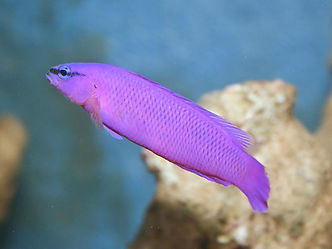
16-Zebra Barred Dartfish
Ptereleotris zebra
Minimum Tank Size: 30 gallons
Care Level: Easy
Temperament: Peaceful
Reef Compatible: Yes
Water Conditions: 72-78° F, dKH 8-12, pH 8.1-8.4, sg 1.020-1.025
Max. Size: 4"
Color Form: Green, Orange
Diet: Carnivore
Compatibility: View Chart
Origin: Fiji, Indonesia, Maldives
Family: Microdesmidae
The Zebra Barred Dartfish is also referred to as the Zebra Dart Goby, Bar Goby, Barred Dartfish, Zebra Goby, or Chinese Zebra Goby. Both the head and body of the Zebra Dart Goby are light green. Its attractive slender body has numerous vertical, evenly-spaced thin orange stripes displaying an intricate pattern.
A tank of at least 30 gallons or larger with a sandy bottom, plants, and coral will provide a healthy environment. Small groups or pairs tend to do better in an aquarium than a single individual, but all need to be introduced to the tank simultaneously and have plenty of swimming room.
The meaty diet of the Bar Goby should include fresh or frozen seafood and brine and mysis shrimp.
Approximate Purchase Size: Indo-Pacific: Small 1-1/2 to 2", Medium 2" to 2-1/2", Large 2-1/2" to 3", Xlrg 3" to 4"


16- Clown Goby, Citrinis
Gobiodon citrinus
Minimum Tank Size: 10 gallons
Care Level: Easy
Temperament: Peaceful
Reef Compatible: Yes
Water Conditions: 72-78° F, dKH 8-12, pH 8.1-8.4, sg 1.020-1.025
Max. Size: 2"
Color Form: Blue, Tan, Yellow
Diet: Carnivore
Compatibility: View Chart
Origin: Fiji, Indonesia, Maldives
Family: Gobiidae
The Citrinis Clown Goby, also known as the Citron or Citrin Goby, is common within the reefs of Sri Lanka and the Coral Sea. They are usually found among soft and hard coral colonies. They are a small yellow fish with blue vertical lines around the eyes and gills, and a blue horizontal line along the dorsal fin. Their body color can vary between dark brown and pale yellow. They are a peaceful fish that makes a wonderful addition to a reef aquarium containing colonies of polyp coral and other soft corals, as they enjoy swimming and hiding amongst the polyps.
The Citrinis Clown Goby feeds on the mucous polyps of Acropora sp. in the wild and is considered reef safe but will nip at the polyps or bases of Acropora sp. and possibly other SPS corals. If the SPS dominated aquarium is not heavily stocked with very mature colonies these fish may severely damage Acropora sp. in these displays.
It requires a 10 gallon or larger aquarium and prefers branched corals, often resting on them for hours at a time. It will rarely become aggressive towards other fish, but will fight with its own kind in smaller tanks. It is best if it is kept with other docile species.
It is common for clown gobies to spawn in an aquarium. Caution should be exercised if the aquarium contains Acropora sp. or similar SPS corals. They will lay their eggs on the underside of the coral's branch, which will cause tissue recession in that area of the coral.
The Citrinis Clown Goby's diet should consist of a variety of brine shrimp, frozen mysis shrimp, table shrimp, and frozen food preparations for carnivores.
Approximate Purchase Size: 1-1/2" to 2"

17-Firefish
Nemateleotris magnifica
Minimum Tank Size: 10 gallons
Care Level: Easy
Temperament: Peaceful
Reef Compatible: Yes
Water Conditions: 72-78° F, dKH 8-12, pH 8.1-8.4, sg 1.020-1.025
Max. Size: 3"
Color Form: Orange, Red, White, Yellow
Diet: Carnivore
Compatibility: View Chart
Origin: Africa, Coral Sea, Indonesia, Maldives
Family: Gobiidae
The Firefish is one of the more popular fish in the marine hobby. It is a magnificent fish with brilliant coloration, a unique body shape, and unparalleled personality. Also known as the Firefish Goby, Fire Goby, and Magnificent or Fire Dartfish, Nemateleotris magnifica has a yellow head, white anterior, and pinkish to orange-red posterior. The dorsal, anal, and caudal fins are highlighted in black. In addition to its striking coloration, the Firefish Goby is also heralded as a sweet-tempered fish with lots of personality. And, because of its small size, the Firefish Goby makes a great addition to the smaller reef system.
In the wild, the Firefish Goby is usually found in groups hovering over the reef, harvesting planktonic food that drifts by in the current. The docile, Firefish Goby is timid and in the wild, each will have a "bolt-hole" into which it quickly ducks when threatened. In the home aquarium, the Firefish Goby needs multiple safety zones amongst rocky crags or outcroppings into which it can dart if stressed. This member of the Gobiidae family is generally not aggressive towards other fish except those of its own species. However, a mated pair can live peacefully together.
To best recreate their wild habitat, the Firefish Goby requires a 10-gallon or larger system with moderate lighting conditions and a moderate current passing over the live rock "reef." Keep in mind that a stressed Firefish Goby will try to jump out of your aquarium. As such, house the Firefish Goby in aquarium systems with a lid. Hobbyists who use a halide system with an open top should construct a Plexiglas "edge" around the trim, at least 10" tall.
Along with algae and zooplankton growing in the aquarium, the diet of the Firefish Goby should consist of finely chopped small crustaceans, vitamin-enriched brine fish (live or frozen), mysis shrimp, and prepared foods.
Approximate Purchase Size: Small: 1" to 1-1/2"; Medium: 1-1/2" to 2"; Large: 2" to 3"

18- Firefish, Purple
Nemateleotris decora
Minimum Tank Size: 10 gallons
Care Level: Easy
Temperament: Peaceful
Reef Compatible: Yes
Water Conditions: 72-78° F, dKH 8-12, pH 8.1-8.4, sg 1.020-1.025
Max. Size: 3¼"
Color Form: Purple, Red, White, Yellow
Diet: Carnivore
Compatibility: View Chart
Origin: Indonesia
Family: Gobiidae
The Purple Firefish, also known as the Decorated Firefish, Purple Dartfish, Decorated Dartfish, or Flame Firefish, was first discovered in the Indo-west-Pacific Ocean in 1973 by Randall and Allen. The colorful body base is varied degrees of yellow to white, and deep shades of purple which begin at the head and ends with maroon-tipped fins.
It requires a 10 gallon or larger aquarium with plenty of loose coral rubble as part of the aquascape, and a tight-fitting lid to prevent it from jumping out of the tank. It will rarely become aggressive towards other fish, but is territorial, and will fight with its own kind unless they are a mated pair.
The Purple Firefish will feed mostly on prey suspended in the water column, but will pick food off the substrate. Its varied diet should consist of chopped or shaved seafood, frozen food preparations for carnivores, vitamin-enriched brine shrimp, and mysis shrimp. The vibrant coloring will fade if not fed a vitamin-enriched diet.
Approximate Purchase Size: 1-3/4" to 2-3/4"

19- Flame Hawkfish
Neocirrhites armatus
Minimum Tank Size: 30 gallons
Care Level: Easy
Temperament: Semi-aggressive
Reef Compatible: With Caution
Water Conditions: 72-78° F, dKH 8-12, pH 8.1-8.4, sg 1.020-1.025
Max. Size: 4"
Color Form: Red
Diet: Carnivore
Compatibility: View Chart
Origin: Fiji, Tahiti
Family: Cirrhitidae
The Flame Hawkfish, also known as the Brilliant Hawkfish, has a bright red body with dark markings along the dorsal fin and around the eyes. They are a very personable fish, and are great for reef aquariums as long as there are no small shrimp maintained in the aquarium.
It requires a 30 gallon or larger aquarium with plenty of live rock for structure and hiding. They are mostly a peaceful fish that spends most of its time perching and swimming within the branches of hard corals. Use caution when adding to an aquarium with small species of bottom dwelling gobies and blennies. They are bottom dwellers and tend to "hang out" on rock perches, waiting and readying themselves for food to come by.
The Flame Hawkfish diet should include a variety of marine meats, frozen preparations, and live feeder shrimp.
Approximate Purchase Size: Small: 3/4" to 1-1/2"; Medium: 1-1/2" to 2-1/2"; Large: 2-1/2" to 3-1/2"

20- Neon Blue Goby
Elactinus oceanops
Minimum Tank Size: 10 gallons
Care Level: Easy
Temperament: Peaceful
Reef Compatible: Yes
Water Conditions: 72-78° F, dKH 8-12, pH 8.1-8.4, sg 1.020-1.025
Max. Size: 2"
Color Form: Black, Blue
Diet: Carnivore
Compatibility: View Chart
Origin: Captive-Bred - USA
Family: Gobiidae
The Neon Blue Goby, or Neon Goby, is known for its gorgeous electric blue stripes. The head and sleek body of the Neon Blue Goby are dark blue with a striking horizontal, light-blue stripe on each side of the body. These signature stripes begin above the eyes and run the entire length of the body. The Neon Blue Goby is a very hardy fish and because of its small size, it makes a great addition to smaller nano reef aquariums.
The Neon Blue Goby should be housed in a 10 gallon or larger aquarium. Rarely will it become aggressive towards other fish. However, the Neon Blue Goby is territorial and will demonstrate aggression towards its own kind unless they are a mated pair. It is common for the Neon Blue Goby to spawn in an aquarium, laying its eggs in a crevice or empty shell.
In the wild, parasites picked off larger reef fish make up a portion of the Neon Blue Goby's natural diet. However, in the home aquarium, the Neon Blue Goby needs to be fed a variety of live and frozen brine shrimp, frozen mysis shrimp, table shrimp, and frozen food preparations for carnivores. If kept in a reef aquarium, the Neon Blue Goby should be fed once per day.
Approximate Purchase Size: Small: 1/2" to 1" Medium: 1" to 1-3/4"

21-Sleeper Banded Goby
Amblygobius phalaena
Minimum Tank Size: 30 gallons
Care Level: Easy
Temperament: Peaceful
Reef Compatible: Yes
Water Conditions: 72-78° F, dKH 8-12, pH 8.1-8.4, sg 1.020-1.025
Max. Size: 6"
Color Form: Blue, Green, Orange, Tan, Yellow
Diet: Omnivore
Compatibility: View Chart
Origin: Fiji, Indonesia, Sumatra
Family: Gobiidae
The Sleeper Banded Goby, also known as the Brownbarred Goby and Bullet Goby, was first discovered in the Indo-Pacific Ocean by Valenciennes in 1837. It has a greenish-yellow head with blue and orange dots and dashes. The remainder of the body is yellow with brown bands.
It should be housed in a 30 gallon or larger aquarium with a substrate of loose coral rubble, and a tight-fitting lid to prevent it from jumping out of the tank. It will rarely become aggressive towards other fish, but is territorial, and will fight with its own kind unless they are a mated pair.
It feeds on a variety of tiny crustaceans in the substrate as well as filamentous algae. In the home aquarium offer a varied diet consisting of vitamin-enriched brine shrimp (live or frozen), mysis shrimp, prepared foods for herbivores, as well as nori strips of the aquarium lacks macro algae growth. It should be fed three times per day, depending on the amount of natural live food found within the aquarium.
Approximate Purchase Size: 1-1/2" to 3"

22- Pink Spotted Watchman Goby
Cryptocentrus leptocephalus
Minimum Tank Size: 30 gallons
Care Level: Easy
Temperament: Peaceful
Reef Compatible: Yes
Water Conditions: 72-78° F, dKH 8-12, pH 8.1-8.4, sg 1.020-1.025
Max. Size: 4"
Color Form: Blue, Red, Tan, Yellow
Diet: Carnivore
Compatibility: View Chart
Origin: Cebu, Solomon Islands, Sri Lanka
Family: Gobiidae
The Spotted Watchman Goby is also known as the Pink and Blue Spotted, Singapore Shrimp, Leptocephalus Prawn, or Pinkspotted Shrimp Goby. The head and body are yellow to tan with pink spots surrounded by smaller blue spots.
It requires a 30 gallon or larger aquarium with plenty of loose coral rubble, ample swimming room, and a sand bottom for burrowing. It rarely becomes aggressive towards other fish, but it is territorial, and will fight with its own kind unless they are a mated pair. It may try to jump out of the aquarium or other small openings, therefore, a tight-fitting lid is required.
The Spotted Watchman Goby diet should include a variety of mysis shrimp, vitamin-enriched brine shrimp, table shrimp, and frozen food preparations for carnivores. It should be fed at least twice per day.
Approximate Purchase Size: Medium: 2" to 3"; Large: 3" to 4"



